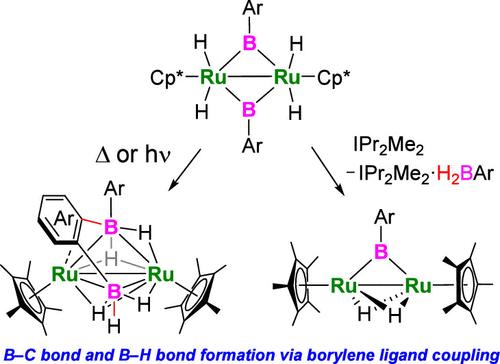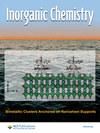Reactivity of Diruthenium Bisborylene Complexes: Formation of B–C and B–H Bonds via Borylene Ligand Coupling
IF 4.3
2区 化学
Q1 CHEMISTRY, INORGANIC & NUCLEAR
引用次数: 0
Abstract
Thermal or photoinduced isomerization of diruthenium bridging bisborylene complexes [{Cp*(H)2Ru}2(μ-BAr)2] (1a, Ar = Ph; 1b, Ar = 3,4,5-F3C6H2) led to nido-ruthenacarboranes 2a and 2b with newly formed B–C and B–H bonds. The reaction mechanism was analyzed by deuterium-labeling experiments and density functional theory calculations. Additionally, 2-fold B–H coupling between borylene and two hydrido ligands of 1a can be achieved, assisted by Lewis base IPr2Me2 to generate a dinuclear bridging borylene complex [(Cp*Ru)2(μ-H)2(μ-BPh)] (3). Our results provide new reactivity patterns for borylene-based functionalizations.

双硼铱钌配合物的反应性:通过双硼烯配体偶联形成 B-C 和 B-H 键
热或光诱导的二钌桥双硼烷配合物[{Cp*(H)2Ru}2(μ-BAr)2](1a,Ar = Ph;1b,Ar = 3,4,5-F3C6H2)的异构化导致了具有新形成的 B-C 和 B-H 键的硝基钌硼烷 2a 和 2b。通过氘标记实验和密度泛函理论计算分析了反应机理。此外,在路易斯碱 IPr2Me2 的帮助下,硼烯和 1a 的两个氢配体之间可以实现 2 倍 B-H 耦合,生成双核桥接硼烯配合物[(Cp*Ru)2(μ-H)2(μ-BPh)] (3)。我们的研究结果为基于硼烯的官能化提供了新的反应模式。
本文章由计算机程序翻译,如有差异,请以英文原文为准。
求助全文
约1分钟内获得全文
求助全文
来源期刊

Inorganic Chemistry
化学-无机化学与核化学
CiteScore
7.60
自引率
13.00%
发文量
1960
审稿时长
1.9 months
期刊介绍:
Inorganic Chemistry publishes fundamental studies in all phases of inorganic chemistry. Coverage includes experimental and theoretical reports on quantitative studies of structure and thermodynamics, kinetics, mechanisms of inorganic reactions, bioinorganic chemistry, and relevant aspects of organometallic chemistry, solid-state phenomena, and chemical bonding theory. Emphasis is placed on the synthesis, structure, thermodynamics, reactivity, spectroscopy, and bonding properties of significant new and known compounds.
 求助内容:
求助内容: 应助结果提醒方式:
应助结果提醒方式:


